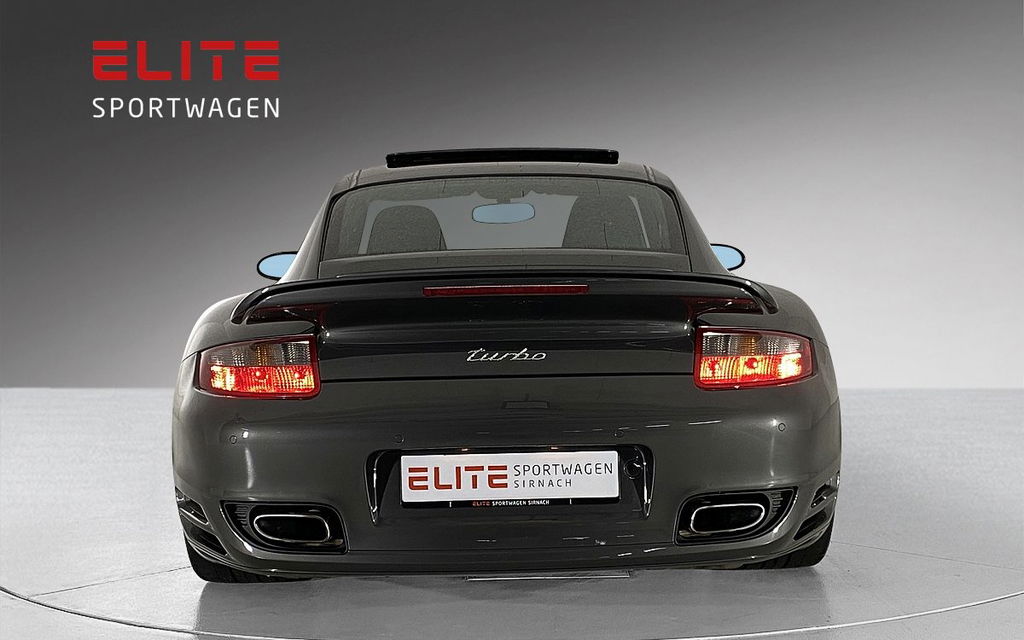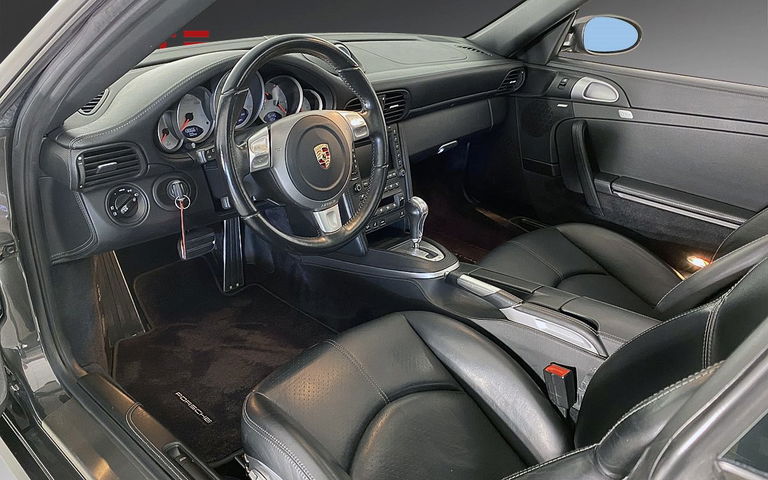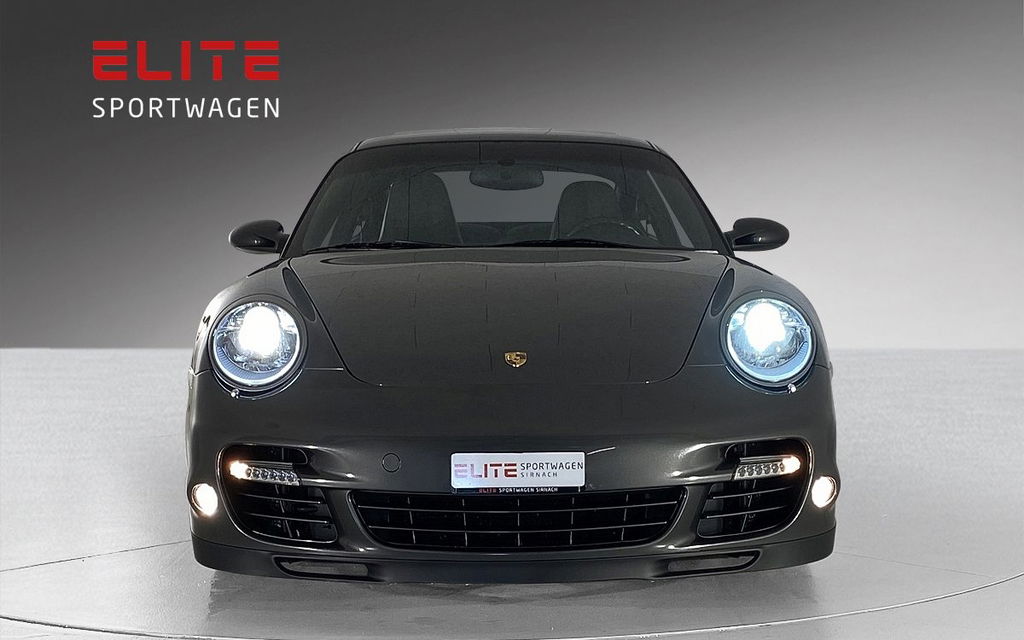Porsche 997 Turbo
Highlights
- PORSCHE - Exclusive special equipment
- Vehicle with history and inspection documents
- Very well maintained vehicle
PORSCHE 911 / 997 turbo tiptronic – 480 HP
Stable speed naturally aspirated engines are currently very popular with super sports cars. But in the recent flood of naturally aspirated engines, the forced induction turbo fraction is by no means falling behind. On the contrary: With a double charger and the world's first petrol engine with variable turbine geometry, the Porsche 911 Turbo is celebrating a splendid comeback. What's more, this 911 pretty much drives the entire competition into the ground – and does so surprisingly smoothly.
Despite 1,000 degrees
But what's new about the variable turbine geometry? For years, this principle has been providing diesel engines with more pressure from below and a more harmonious performance characteristic. The big problem with the gasoline engine: the variable impellers of the exhaust turbocharger have to withstand 1,000 degrees instead of 800 with the diesel. In order to withstand this hellish heat, Porsche first had to find the right material. It took around five years from the development contract to the technology being ready for series production.
Stripped down all-wheel drive
In Zuffenhausen, they are justifiably very proud of the result. Even if the new high-tech impellers sometimes glow white hot under full load, they work perfectly. When driving, however, it is not so much this innovative technology that impresses, but above all the almighty 480 hp performance. Admittedly, compared to many other super sports cars, the turbo-charged 3.6-liter boxer engine does not set a new record in terms of performance. Nevertheless, the pumped-up 911 is way ahead on the track. Other technical highlights help it achieve this impressive performance: thanks to the increased use of aluminum, the weight has been reduced by five kilograms compared to its predecessor. In addition, thanks to the all-wheel drive technology and traction control, the excessive power is converted primarily into propulsion.
It goes full throttle with full pressure
And so the 911 Turbo shows its aggressiveness right from the start. Turbo lag, i.e. the delayed response of the charger when exhaust pressure is low, is barely noticeable. From around 1,800 rpm, the boost pressure builds up noticeably. The boost pressure indicator on the speedometer initially shows 0.2, then 0.4 and then 0.6 bar. The maximum torque of 620 Newton meters is available from 1,950 to 5,000 rpm. In view of what is still to come, this increase in boost pressure and forward thrust seems almost restrained. Just before 3,000 rpm and at 1.0 bar, the whirlwind is fully unleashed. If you want even more power, you should order the Sport Chrono package: for just under 1,500 euros, you can increase the maximum torque to 680 Newton meters at the touch of a button. This short-term overboost ensures even more power.
To 100 km/h in 3.7 seconds
Let's not make a metaphorical comparison with vehicles from the aerospace or aviation industry at this point: No, the 911 Turbo does not accelerate like a rocket, but like an extremely fast and powerful super sports car. But this is not a capricious diva. Tail-swinging, squeaking wheels and tugging on the steering? Not at all! If you change into second gear quickly enough, you can manage the 100 km/h sprint in 3.9 seconds. This discipline is even shortened with the automatic Tiptronic S transmission: Porsche claims 0 to 100 km/h in 3.7 seconds and 200 km/h in 12.2 seconds. Any questions?
An extreme without extremes
Despite these extremes, the Turbo is an acoustically restrained 911 with its subtle rumble and roar. On the other hand, beyond 2,000 rpm at full throttle there is the typical turbo whistle. That may not sound so macho, but it still has its appeal. The mixture of all-wheel drive and turbo sound has one crucial, but also very subjective, disadvantage: the top model in the 911 series is pretty much the fastest on four wheels ever, and yet you would hardly feel that way. It also lacks the stimulation of a wild and unbridled character. Up to 7,000 rpm the water-cooled six-cylinder boxer seems effortless. If you don't shift up in time, the acceleration orgy ends relatively gently in the limiter. The gears slip even better and easier than in the normal Carrera. Even those who aim for the maximum possible 310 km/h will be surprised by the almost docile handling. The 911 Turbo does not allow any uncertainty to arise.
Sporty and precise, yet comfortable
The extra-hard chassis of a super sports car is also foreign to the currently most powerful 911. Even in the electronic damper setting "Sport", it still goes over bumps quite smoothly. On the other hand, the normal setting does not seem spongy at all. The steering may occasionally seem a little imprecise at cruising speed on the motorway. Here, the large 19-inch rims with their 235 rubber will probably follow some ruts. But beyond that, a high degree of precision is required. This impression is also conveyed by the particularly large and stable ABS brakes, which can also be made of ceramic if desired.
Not for penny pinchers
The new 911 Turbo is also civil in terms of consumption. At 12.8 liters (13.6 liters with Tiptronic), the average consumption has even been slightly reduced compared to the predecessor. After around 300 kilometers on our test drive, the on-board computer showed 16.5 liters. That sounds a lot, but considering the driving performance, it is a very good value. And anyway, the classic 911 customers are likely to smile mildly at the question of fuel consumption. The 911 Turbo will be available from July 8, 2006 for 133,603 euros. Anyone who buys in this price range will hardly have to worry about slightly higher fuel costs.
Translated by Google Translate





























